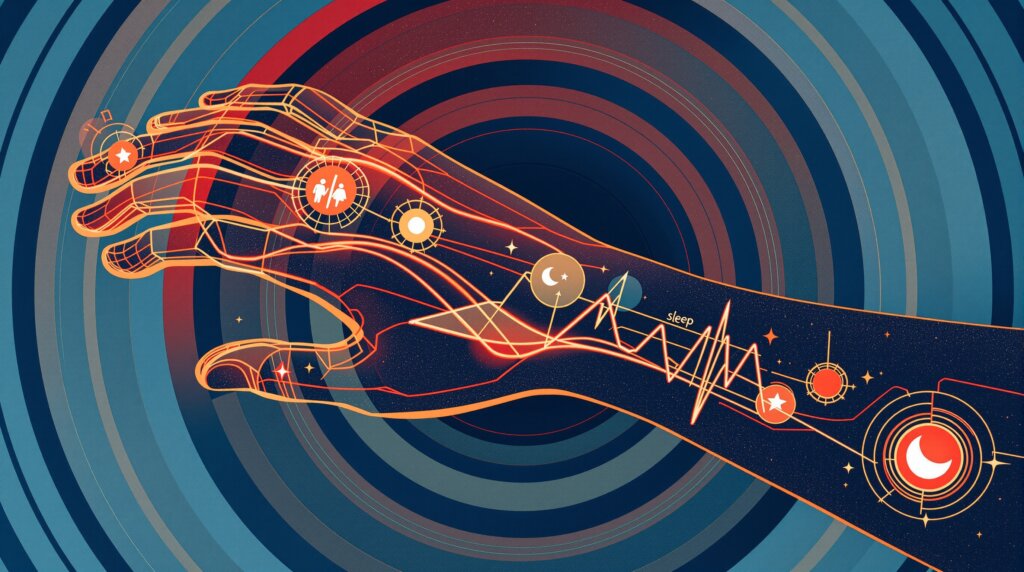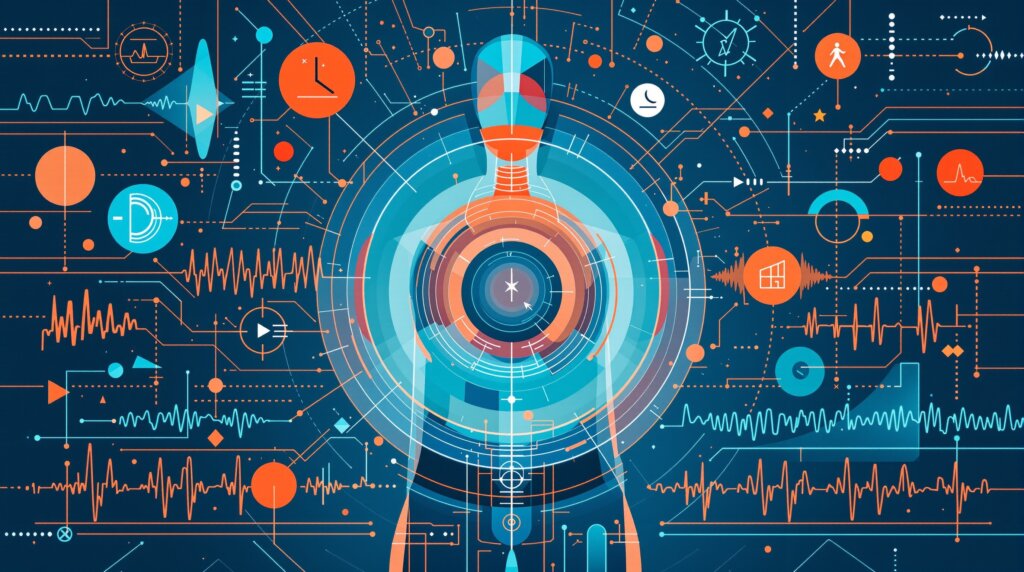Understanding the Heartbeat of Longevity
What Makes Heart Rate Variability So Important?
Heart rate variability (HRV) represents one of the most fascinating windows into our body’s internal balance and aging process. Unlike your resting heart rate, which measures the average beats per minute, HRV examines the subtle variations in timing between each heartbeat. This seemingly small difference reveals profound insights about your autonomic nervous system—the unconscious control center that manages everything from stress response to recovery.
The physiological basis of HRV lies in the delicate dance between your sympathetic nervous system (your body’s “fight or flight” response) and your parasympathetic nervous system (the “rest and digest” mode). When these systems work in harmony, they create healthy variability in your heart rhythm. Recent research suggests this variability may serve as a powerful predictor of not just current health, but longevity potential itself.

The Science Behind Heart Rate Variability
How Your Autonomic Nervous System Controls Longevity Signals
Heart rate variability measures the variation in time intervals between consecutive heartbeats, typically expressed in milliseconds. While it might seem counterintuitive, a more variable heart rate often indicates better health. This variability reflects your autonomic nervous system’s ability to adapt and respond to changing internal and external conditions.
Your sympathetic nervous system accelerates heart rate during stress or physical activity, while your parasympathetic nervous system slows it down during rest and recovery. The constant interplay between these two systems creates natural fluctuations in heart rhythm. Scientists measure HRV using various methods, including time-domain metrics (like RMSSD, which calculates root mean square of successive differences) and frequency-domain analysis that examines different frequency bands of heart rate oscillations.
This non-invasive biomarker has gained significant attention because it provides real-time insights into autonomic function without requiring complex medical procedures. However, HRV measurements can be influenced by factors like hydration levels, illness, and even the time of day, making consistent measurement conditions important for reliable tracking.
The Longevity Connection: What Research Reveals
Scientific Evidence Linking HRV to Lifespan
The relationship between heart rate variability and longevity has captured researchers‘ attention for good reason. Multiple longitudinal studies have consistently shown that individuals with higher HRV tend to live longer, healthier lives. Perhaps most remarkably, studies of centenarians—people who live to 100 and beyond—often reveal preserved or even increased parasympathetic activity, suggesting that maintaining strong autonomic function may be crucial for exceptional longevity.
Research examining cardiovascular mortality has found that low HRV serves as an independent predictor of death risk, even after accounting for traditional cardiovascular risk factors like blood pressure and cholesterol levels. This predictive power extends beyond heart disease to include various age-related conditions, suggesting that HRV reflects broader physiological resilience.
The mechanism behind this connection likely involves HRV’s role as an indicator of adaptability and stress resilience. Individuals with higher HRV demonstrate better capacity to recover from physical and psychological stressors, maintain stable blood pressure, and preserve cardiovascular function over time. This enhanced resilience appears to translate into protection against the accumulation of cellular damage that characterizes aging.
However, it’s important to note that while the correlation between HRV and longevity is strong, the relationship isn’t always straightforward. Some studies have found that extremely high HRV can sometimes indicate underlying cardiac issues, emphasizing the importance of interpreting HRV data within the broader context of overall health status.
How HRV Changes as We Age
The Natural Decline and Notable Exceptions
Age-related changes in heart rate variability follow a generally predictable pattern, though individual variations can be quite significant. Most people experience a gradual decline in HRV starting around age 30, with the rate of decline accelerating after age 50. This reduction primarily reflects decreased autonomic flexibility and increased dominance of sympathetic nervous system activity over parasympathetic function.
The aging process tends to shift our autonomic balance toward a more chronically stressed state, with reduced capacity for the deep recovery states that characterize healthy parasympathetic function. This shift may contribute to increased inflammation, reduced sleep quality, and decreased stress resilience—all hallmarks of biological aging.
Interestingly, studies of exceptionally long-lived individuals reveal a fascinating exception to this pattern. Some centenarians show preserved or even increased parasympathetic activity compared to younger elderly adults, suggesting that maintaining autonomic balance may be a key factor in achieving exceptional longevity. This finding has led researchers to investigate whether HRV might serve as a marker of biological age rather than simply chronological age.
The concept of biological versus chronological age has gained considerable attention in longevity research, with HRV emerging as one potential biomarker for assessing how well someone is aging at the cellular level. While chronological age measures time since birth, biological age reflects the actual condition of your body’s systems and their functional capacity.
Optimizing HRV for Longevity: Lifestyle Factors That Matter
Evidence-Based Strategies for Improving Heart Rate Variability
The encouraging news about HRV is that it responds positively to lifestyle interventions, offering a actionable pathway for improving autonomic function and potentially extending healthspan. Regular physical activity stands out as one of the most effective methods for enhancing HRV, particularly aerobic exercise and high-intensity interval training. However, the relationship isn’t always linear—excessive training can sometimes temporarily reduce HRV, highlighting the importance of balancing activity with adequate recovery.
Stress management techniques have shown remarkable effectiveness in improving HRV. Practices such as meditation, deep breathing exercises, and yoga can enhance parasympathetic tone and increase heart rate variability. Even brief daily sessions of controlled breathing can produce measurable improvements in autonomic balance within weeks.
Sleep quality plays a crucial role in HRV optimization. During deep sleep stages, parasympathetic activity naturally increases, allowing for cardiovascular recovery and autonomic nervous system restoration. Poor sleep quality or insufficient sleep duration can significantly impair HRV, creating a cycle where reduced autonomic function further compromises sleep quality.
Dietary factors also influence HRV, though the research is still evolving. Some studies suggest that anti-inflammatory diets rich in omega-3 fatty acids and antioxidants may support healthy HRV, while excessive alcohol consumption and highly processed foods tend to have negative effects. The physiological mechanisms behind HRV’s protective effects likely involve reduced ventricular workload, decreased endothelial stress, and improved cardiovascular efficiency—all factors that may contribute to reduced mortality risk and enhanced longevity.
Modern HRV Tracking: Tools and Best Practices
Making HRV Monitoring Accessible and Actionable
The democratization of HRV monitoring through wearable technology has transformed this once laboratory-confined metric into an accessible tool for personal health optimization. Modern devices can provide continuous HRV monitoring or focused measurements during specific periods, typically during sleep or upon waking when autonomic activity is most stable.
For reliable HRV tracking, consistency in measurement conditions proves crucial. The most accurate readings often occur during periods of rest, preferably at the same time each day. Many experts recommend morning measurements, as HRV naturally fluctuates throughout the day in response to various stressors and activities. Advanced wearables with medical-grade sensors can provide the accuracy needed for meaningful long-term tracking, though it’s worth noting that no consumer device is perfectly reliable under all conditions.
Personal HRV baselines vary significantly between individuals, making it more important to track your own trends over time rather than comparing absolute values with others. Short-term fluctuations are normal and can reflect temporary factors like illness, dehydration, or unusual stress. The real value emerges from observing patterns over weeks and months, allowing you to identify how lifestyle changes impact your autonomic function.
Platforms that focus on longevity signals, rather than just basic fitness metrics, can provide more sophisticated HRV analysis and personalized coaching based on your individual patterns. This approach recognizes that optimal health isn’t one-size-fits-all but requires understanding your unique physiological responses and adapting recommendations accordingly.
The Future of HRV in Personalized Longevity Medicine
Emerging Applications and Research Directions
The field of longevity research increasingly recognizes HRV as a valuable biomarker for assessing interventions designed to slow aging and extend healthspan. Emerging studies are exploring how specific anti-aging protocols—from intermittent fasting to targeted supplementation—affect autonomic function as measured through HRV changes.
Future applications may include using HRV data to personalize longevity interventions, helping individuals identify which lifestyle modifications provide the greatest benefit for their unique physiological profile. Integration with other biomarkers, such as continuous glucose monitoring and sleep architecture analysis, promises to create comprehensive pictures of biological age and health optimization opportunities.
The potential for HRV-guided interventions extends beyond individual health optimization to population health strategies, as researchers explore how community-level programs might improve autonomic function and longevity outcomes. However, realizing this potential will require continued research into the complex relationships between HRV, aging, and various health interventions.
Conclusion: Your Heart’s Wisdom for Longevity
Heart rate variability represents far more than a simple health metric—it offers a window into your body’s fundamental capacity for resilience and adaptation. The growing body of research linking higher HRV to increased longevity provides compelling evidence that autonomic nervous system health plays a crucial role in how we age and how long we live.
By understanding and tracking your HRV patterns, you gain access to real-time feedback about how your lifestyle choices affect your body’s stress response and recovery capacity. This knowledge empowers you to make informed decisions about exercise, stress management, sleep optimization, and other factors that influence not just how you feel today, but how well you’ll age in the decades to come. The heart’s variability, it turns out, may hold one of the keys to a longer, healthier life.
Frequently Asked Questions
What is heart rate variability (HRV) and why does it matter for longevity?
Can a smartwatch accurately track HRV?
How often should I measure HRV to monitor my long-term health?
What changes in HRV should I be concerned about?
How can I improve my HRV to support longevity?



